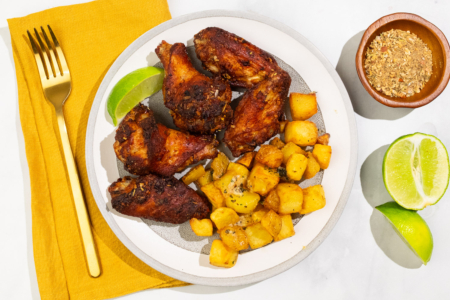Perilla leaves, a staple in Korean cuisine, are worth seeking out for their fresh, herbal flavor, but finding them is complicated because of confusion surrounding their name. We’ve decoded the names, history, and uses of perilla below.
What’s in a Name? Perilla, Explained
Perilla (Perilla frutescens) is an annual plant that can grow up to three feet tall. Its leaves are round or spade-shaped, with a slightly fuzzy texture and serrated edges. Their size, 2 to 3 inches wide and up to 6 inches in height, is an advantage in many of the Korean dishes in which they are used.
The confusion with perilla is partly based on language translation and partly based on botanical classification. Let’s start with translation. The Korean word for perilla is kkaennip or kka nnip, which translates to “sesame leaf.” In English-speaking areas, therefore, it may be called sesame leaf, despite the fact that the sesame plant belongs to a completely different genus.
Perilla’s botanical classification adds to the confusion. Perilla (Perilla frutescens) was long considered a different species from Perilla frutescens var. crispa, which is the scientific name for shiso, a leaf commonly used in Japanese cuisine. In recent years, however, the two plants have been shown to share a common gene pool, and shiso is now classified as a variant of the perilla species. Shiso leaves have a similar look, though smaller, more serrated at the edges, and more pronounced flavor.
History

Native to the mountainous regions of Asia, perilla leaves are used for both their culinary and medicinal properties. They have long been used in traditional medicine to help soothe a variety of symptoms, like food poisoning, morning sickness, and the cough and chest congestion from a cold. Some also believe that the leaves have anti-carcinogenic and anti-inflammatory properties. The first documented use of perilla is a Chinese medicinal formula from 1110 BCE. Trade brought perilla to the rest of Asia and, in the late 1800s, to the U.S. Today, the leaves are popularly used in Korean cuisine.
Flavor
Perilla leaves are highly aromatic. Their herbaceous flavor is often described as a cross between mint and anise (licorice), with notes of basil. Specialty Produce recommends pairing perilla with a variety of ingredients such as chili, garlic, soy sauce, tofu, grilled meats, citrus fruits, stone fruit, green tea, and soft cheeses.
Uses

Perilla leaves can be used both raw and cooked. Raw, they are commonly used as a wrap for rice, barbecued meats, sushi, and vegetables. They are found sliced and added to salads, or used as a garnish. Cooked, the leaves are stir-fried with garlic and vegetables, sliced and mixed into bread or savory pancakes, or deep-fried in batter for a crunchy side dish. Looking to cook with perilla at home? Serious Eats has a recipe for marinated perilla with soy sauce, sesame oil, vinegar, garlic, and Korean chili powder that would make a great side dish.
Where Can I Find It?
In the U.S, perilla leaves can often be found at specialty grocers. They may be labeled as sesame leaves, or as any of the following colloquial names: Kkaennip, Kka Nnip, Beefsteak plant, Wild Coleus, Purple mint, or Shiso.




Can you drink it like peppermint